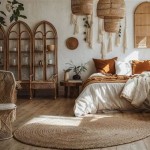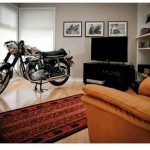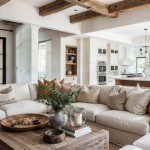Unique Decorating Ideas for Room Transformation
Room decoration transcends mere aesthetics; it’s about crafting an environment that reflects personality, fosters well-being, and harmonizes with lifestyle. Moving beyond conventional approaches can lead to spaces that are not only visually appealing but also deeply personal and functional. This article explores some unique decorating ideas for transforming rooms into truly distinctive and inspiring spaces.
Embracing Maximalism with Intention
While minimalism often reigns in modern design, maximalism offers a contrasting approach, embracing abundance and personalization. Maximalism, however, should not be confused with clutter. The difference lies in intentionality. A maximalist room features a curated collection of items, each contributing to a cohesive, albeit visually rich, aesthetic.
One key element of intentional maximalism is the careful selection of color palettes. Instead of a single dominant color, maximalist spaces frequently employ layers of complementary or contrasting hues. This might involve a deep jewel-toned wall paired with furniture in vibrant, patterned fabrics, and accessories in metallic or textured finishes. The key is to ensure the colors harmonize rather than clash, creating a sense of visual unity despite the abundance of elements.
Another aspect of intentional maximalism is the strategic use of texture. Combining smooth surfaces with rough textures, like velvet upholstery with woven rugs and metallic accents, adds depth and intrigue to the space. Utilizing different materials, such as wood, glass, and metal, further enhances the tactile experience and prevents the room from appearing flat or monotonous.
Artwork and personal collections play a significant role in defining a maximalist space. Instead of a few carefully chosen pieces, maximalism encourages the display of a larger collection, whether it be paintings, sculptures, photographs, or other objects of sentimental or aesthetic value. Gallery walls, where multiple pieces are arranged closely together, are a common feature of maximalist design. Careful arrangement of these pieces, considering size, color, and theme, is crucial for maintaining visual balance and preventing the space from appearing chaotic.
Finally, lighting is essential for highlighting the various elements within a maximalist room. A combination of ambient, task, and accent lighting can illuminate different areas and draw attention to specific features. Chandeliers, sconces, and table lamps can be used to create a warm and inviting atmosphere, while spotlights can highlight artwork or architectural details.
Incorporating Biophilic Design for Wellness
Biophilic design focuses on connecting inhabitants with the natural environment through the incorporation of natural elements and patterns within the built environment. The premise is that humans have an innate connection to nature, and integrating natural elements into indoor spaces can improve well-being, reduce stress, and enhance productivity.
One of the most direct ways to incorporate biophilic design is through the introduction of indoor plants. Plants not only add visual appeal but also improve air quality and create a sense of tranquility. Different types of plants can be used to create different moods and effects. Large, leafy plants can create a sense of lushness and abundance, while smaller succulents and cacti can add a touch of minimalist elegance. Vertical gardens, where plants are grown on walls, are an innovative way to maximize space and bring nature into even the smallest rooms.
Natural light is another essential element of biophilic design. Maximizing natural light exposure through large windows, skylights, or light wells can have a significant impact on mood and energy levels. Where natural light is limited, full-spectrum lighting can be used to mimic the effects of sunlight. Strategic placement of mirrors can also help to reflect and amplify natural light, making the space feel brighter and more open.
The use of natural materials, such as wood, stone, bamboo, and cork, is another key aspect of biophilic design. These materials bring a sense of warmth and texture to the space, creating a connection to the natural world. Wood flooring, exposed brick walls, and stone countertops are all examples of how natural materials can be incorporated into the design. Even smaller details, such as wooden picture frames or stone vases, can contribute to the overall biophilic aesthetic.
Patterns and textures found in nature can also be incorporated into biophilic design. This might involve using fabrics with organic patterns, such as floral prints or leaf motifs, or incorporating textures that mimic natural surfaces, such as wood grain or stone. Even the arrangement of furniture can be inspired by natural patterns, such as the spiral arrangement of a seashell or the branching pattern of a tree.
Finally, incorporating elements of water, such as a small fountain or aquarium, can further enhance the biophilic design. The sound of running water can be calming and soothing, while the movement of fish can be visually stimulating. Even a simple bowl of water with floating flowers can add a touch of tranquility to the space.
Repurposing and Upcycling for Sustainable Style
In an era of increasing environmental awareness, repurposing and upcycling offer sustainable and creative approaches to room decoration. Instead of discarding old or unwanted items, repurposing involves finding new uses for them, while upcycling involves transforming them into something of higher value. This not only reduces waste but also adds a unique and personal touch to the space.
One common example of repurposing is using old furniture for new purposes. An old dresser can be transformed into a bathroom vanity, or a vintage suitcase can be used as a side table. The possibilities are endless, and the only limit is imagination. When repurposing furniture, it is important to consider the functionality and aesthetics of the new design. Sanding, painting, and adding new hardware can help to transform the piece and make it suitable for its new purpose.
Upcycling involves transforming discarded materials into something of higher value or beauty. Old pallets can be disassembled and used to create furniture, wall art, or even flooring. Glass bottles can be transformed into lamps, vases, or decorative containers. Scrap fabric can be used to create quilts, pillows, or curtains. The key to successful upcycling is to see the potential in the discarded material and to find creative ways to transform it into something new and useful.
Repurposing and upcycling can also extend to decorative elements. Old books can be stacked to create a unique side table, or their pages can be used to create paper flowers or wall art. Vintage maps can be framed and used as decorative prints, or they can be decoupaged onto furniture. Even old clothing can be repurposed into throw pillows or wall hangings.
The process of repurposing and upcycling not only reduces waste but also adds a personal and unique touch to the room. Each piece tells a story and reflects the creativity and ingenuity of the designer. It also encourages a more mindful approach to consumption, as it forces one to consider the potential of discarded items before throwing them away.
When repurposing and upcycling, it is important to consider the safety and durability of the new design. Ensure that any repurposed furniture is stable and secure, and that any upcycled materials are properly cleaned and treated. It is also important to consider the overall aesthetic of the room and to ensure that the repurposed and upcycled pieces complement the existing décor.
By embracing maximalism with intention, incorporating biophilic design, and repurposing and upcycling materials, one can create rooms that are not only visually appealing but also deeply personal, functional, and sustainable. These unique decorating ideas offer a departure from conventional approaches, allowing individuals to express their creativity and create spaces that truly reflect their personalities and lifestyles.

Stylish Bedroom Wall Decor Ideas For Modern N Interiors

20 Diy Room Decor Ideas Designs For Small Kids

30 Stylish Bedroom Wall Decor Ideas And Tips

33 Cool Boho Bedroom Decorating Inspiration For Summer 2025

Small Bedroom Decoration Ideas On A Budget

Kids Room Decorating Ideas That Go From Toddler To Teen

10 Dorm Room Decorating Ideas For A Personalized Retreat Decorilla Interior Design

22 Bedroom Decorating Ideas To Create Cozy Place

22 Trendy Space Saving Dorm Decor Ideas Extra Storage
:max_bytes(150000):strip_icc()/Leanne-Ford-House8394-09b84cfcfe2c43fe9e9536618a673af1-8e5511e9cea74c10bbda67a05d5d46e3.jpg?strip=all)
77 Bedroom Decorating Ideas For Every Budget And Style







